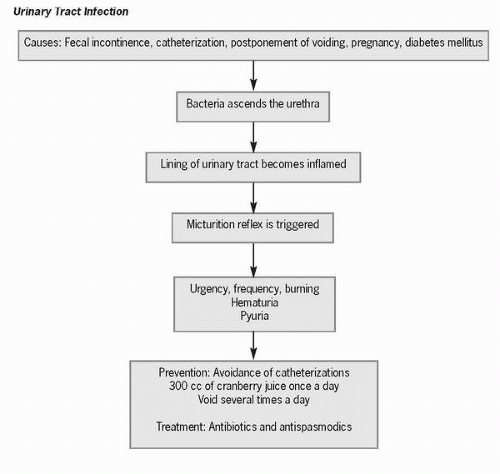Urinary Tract Infections and Hemolytic Uremic Syndrome
UICK LOOK AT THE CHAPTER AHEAD
Urinary tract infections (UTIs) affect the renal system directly, whereas hemolytic uremic syndrome (HUS) affects the renal system indirectly. Pyelonephritis is classified as a tubulointerstitial disorder and is discussed in Chapter 64.
TERMS
UTIs are classified as lower or upper tract infections. Upper UTIs involve the ureters and kidneys, whereas lower UTIs involve the urethra and bladder. Urethritis involves inflammation of the urethra, whereas cystitis indicates inflammation of the bladder. Lower UTIs are the second most common bacterial infections seen by doctors. It is
estimated that 7 million people per year in the United States develop a UTI.
estimated that 7 million people per year in the United States develop a UTI.
Generally, acute UTIs are caused by a single pathogen common to the intestine (most commonly Escherichia coli) and are classified by the primary site affected, whereas chronic UTIs are caused by two or more pathogens. Although there are approximately 150 strains of E. coli, five subgroups are responsible for most UTIs. It has been estimated than 43% of women, 12% of men, 15% to 25% of the elderly living in a nursing home, and 5% to 20% of the elderly living at home will have a UTI sometime during their lifetime. Despite a long urethra, the incidence of UTI in men increases greatly with age as prostatic hypertrophy increases urinary retention and lessened bacteriostatic prostatic secretions (zinc) lower the body’s defense mechanisms against infection.
Pathophysiology
Normally, a UTI is prevented by acidic urine, complete bladder emptying, a competent ureterovesical junction to prevent urine backflow, and bacteriostatic properties of the urethra and bladder. Ordinarily, the urinary tract above the urethra is sterile; therefore, if bacteria ascends the urethra and colonizes the bladder, an inflammatory process is initiated. The process of voiding routinely cleanses the bladder and urethra. Thus, anything that interferes with this process, such as outflow obstruction, postponement of voiding, pregnancy, or diabetes mellitus, increases the risk of a UTI. Use of a spermicide or diaphragms (both alter normal vaginal bacterial flora), fecal incontinence, and catheterization have also been implicated as UTI risk factors. Approximately 1% of adults who have a straight catheterization and almost 100% of patients who have an indwelling catheter develop a UTI within 3 to 4 days of catheter placement.
Bacteria are introduced into the bladder during the catheterization procedure. The process of catheterization also causes irritation and
minute scraping of the urethra, creating a portal for bacterial entry. Additionally, an indwelling catheter prevents normal flushing of the urethra by urine, and bacteria may travel to the bladder through the catheter itself or via the exudate that collects between the outside of the catheter and the urethral walls. As bacteria adhere to the catheter, they produce a protective film that covers the surface of the catheter and protects the bacteria against antibiotic action, making eradication of the infection difficult.
minute scraping of the urethra, creating a portal for bacterial entry. Additionally, an indwelling catheter prevents normal flushing of the urethra by urine, and bacteria may travel to the bladder through the catheter itself or via the exudate that collects between the outside of the catheter and the urethral walls. As bacteria adhere to the catheter, they produce a protective film that covers the surface of the catheter and protects the bacteria against antibiotic action, making eradication of the infection difficult.
Stay updated, free articles. Join our Telegram channel

Full access? Get Clinical Tree






